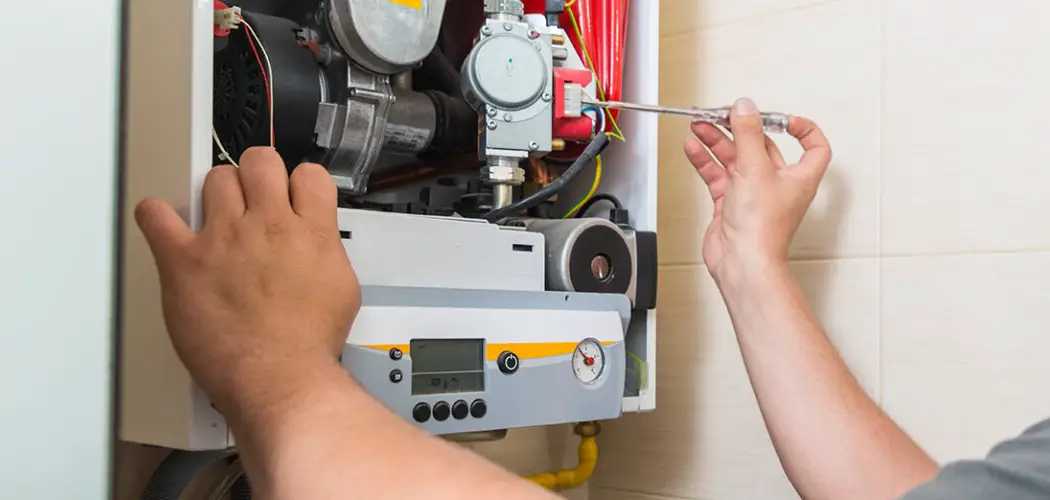Are you having trouble with your home’s furnace? Do you feel like it’s not working as efficiently as it used to? Don’t worry—it’s a common problem that many homeowners face. However, you can take some simple steps to reignite your furnace and have it running smoothly again.
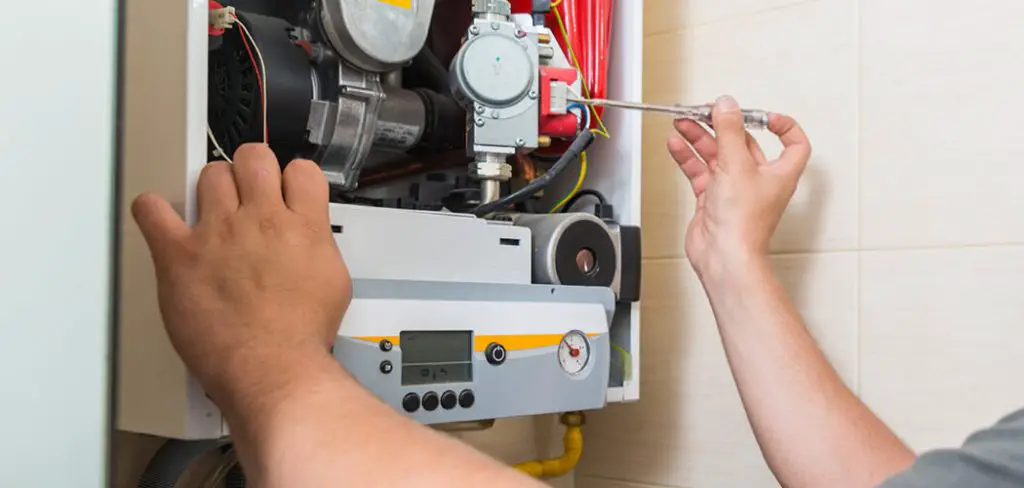
Reigniting a furnace is a critical task during the colder months, ensuring your home remains warm and inviting. Whether it’s after a long summer of disuse or a temporary shutdown for maintenance, restarting your furnace correctly is essential for both safety and efficiency.
This guide will walk you through the necessary steps on how to reignite furnace, highlight common troubleshooting tips, and offer advice on when to call in a professional. Following these instructions, you can confidently keep your living space cozy and comfortable all winter.
What are the Reasons for Furnace Failure?
Before we dive into the process of reigniting your furnace, let’s first understand why it may have stopped working in the first place. Some common reasons for furnace failure include:
- Lack of Maintenance: Regular maintenance is crucial to keep your furnace running smoothly and prevent any major breakdowns.
- Dirty or Clogged Filters: A dirty or clogged filter can restrict airflow and cause the furnace to overheat, causing it to shut down.
- Thermostat Issues: If your thermostat is not functioning correctly, it may not be sending the correct signals to the furnace, resulting in a shutdown.
- Pilot Light or Ignition Problems: A faulty pilot light or ignitor can prevent your furnace from turning on.
- Gas Supply Issues: If your furnace is gas-powered, a disruption in the gas supply can prevent it from igniting.
Understanding these common causes can help you troubleshoot and fix the issue before attempting to reignite your furnace. Now, let’s move on to the steps for reigniting your furnace.
What Will You Need?
Before you start reigniting your furnace, make sure you have the following items on hand:
- Matches or a Lighter: You will need these to light the pilot light or ignitor.
- Flashlight: It’s always helpful to have a flashlight handy, especially if your furnace is located in a dark area.
- Owner’s Manual: This will provide specific instructions for your furnace model, which may differ from the general steps outlined below.
Once you have all the necessary items, you can begin the reignition process.
10 Easy Steps on How to Reignite Furnace
Step 1. Turn Off the Gas:
Before proceeding with any further steps, it’s crucial to ensure your safety by turning off the gas supply to your furnace. Locate the gas valve, which is typically found on the gas line leading to the furnace, and turn the valve handle so it’s perpendicular to the gas pipe.
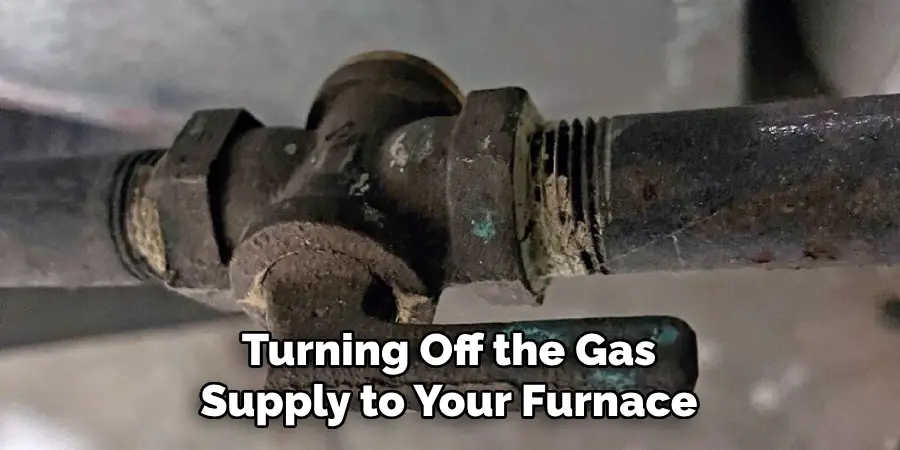
This action effectively halts the flow of gas to the furnace, allowing you to safely work on reigniting the pilot light or ignition system without the risk of gas leakage or a potential fire hazard.
Safety should always be your top priority when dealing with gas appliances. If you need more clarification about the gas valve’s location or how to safely turn it off, refer to your furnace’s owner’s manual for specific guidance or consider consulting a professional.
Step 2. Wait for Any Gas to Disperse:
After turning off the gas, pausing for a few minutes is imperative. This waiting period allows any residual gas in the vicinity of the furnace to disperse, further minimizing the risk of accidental ignition when you reignite the furnace.
During this time, ensure the area is well-ventilated; you should open windows or doors near the furnace to aid in gas dispersion. Safety is paramount, and this step helps to ensure a secure environment before proceeding with the ignition process.
Step 3. Locate the Ignition Mechanism:
After ensuring the gas has dispersed, and the area is well-ventilated, the next step is to locate the ignition mechanism on your furnace. Depending on your furnace model, this can be a pilot light or an electronic ignitor. Usually, the ignition is situated near the bottom of the furnace.
If you need help finding it, refer to the owner’s manual for specific details regarding its location. A flashlight can be very useful during this step, especially if the furnace is located in a poorly lit area. Identifying the correct ignition mechanism is crucial for the successful reignition of your furnace.
Step 4. Turn On the Gas Valve:
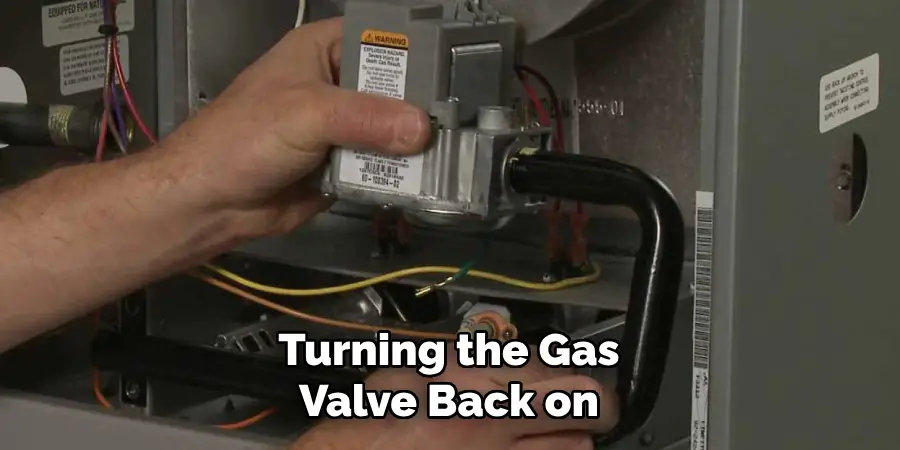
Once you’ve successfully located the ignition mechanism, the next step involves cautiously turning the gas valve back on. This is crucial for reigniting the furnace but must be done with absolute precision and care. Rotate the valve handle gradually to its original position, ensuring that it’s parallel with the gas pipe. This action resumes the flow of gas to the furnace, preparing it for ignition.
It’s important to proceed slowly to control the gas flow and reduce any risks during this process. If at any point you smell gas or suspect a leak, immediately stop and evacuate the area, contacting professionals to handle the situation. Safety must always be the primary concern.
Step 5. Ignite the Furnace:
After ensuring that the gas valve is on and gas flows to the furnace, it’s time to ignite it. If your furnace has a pilot light, use matches or a lighter to light it, following the manufacturer’s instructions found in the owner’s manual. This process may involve pressing an ignition button for furnaces with an electronic ignition. Once the ignition mechanism is activated, observe if the furnace ignites successfully.
It may take a few moments for the flame to stabilize. Keep a safe distance during this step and follow all safety precautions detailed in your furnace’s instruction manual. Patience and caution are key during this process to ensure a safe and successful reignition of your furnace.
Step 6. Check for a Stable Flame:
Once the ignition process is complete, observe the flame to ensure it is stable and burning correctly. A consistent blue flame is an indicator of proper functioning, signifying that the gas is burning efficiently. If the flame appears yellow or flickers excessively, this might indicate a problem, such as a dirty burner or an issue with the gas composition.
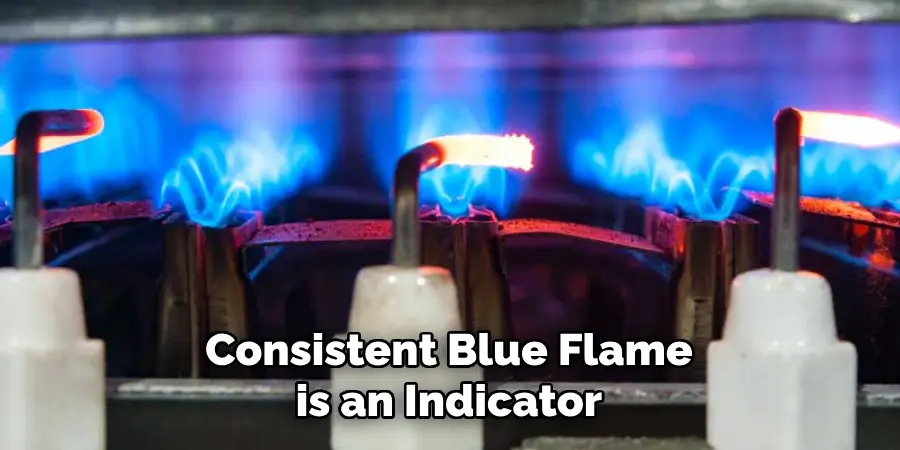
Refer to your owner’s manual for troubleshooting tips if the flame doesn’t seem right. It’s crucial to ensure the flame is stable before proceeding to prevent any potential safety hazards.
Remember, if the furnace doesn’t ignite after several attempts or if you observe unusual flame colors, it’s best to turn off the gas and consult a professional for assistance.
Step 7. Replace or Close the Furnace Cover:
After confirming that the flame is stable and the furnace is functioning as expected, the next step involves replacing the cover of the furnace or closing the access panel.
This cover is crucial for ensuring the safe operation of the furnace, as it prevents dust, debris, and other foreign objects from entering the combustion area. It also helps to protect against accidental contact with the furnace’s internal components.
Carefully place the cover back on the furnace or close the access panel securely. Make sure it is properly aligned and fastened, if applicable. This step not only safeguards the furnace’s components but also maintains the efficiency and effectiveness of its operation.
Step 8. Monitor the Furnace Performance:
After reigniting the furnace and ensuring that the flame is stable, monitoring the furnace’s performance closely for the next several hours is essential. Listen for any unusual noises that might indicate a malfunction, such as banging, whistling, or rattling sounds.
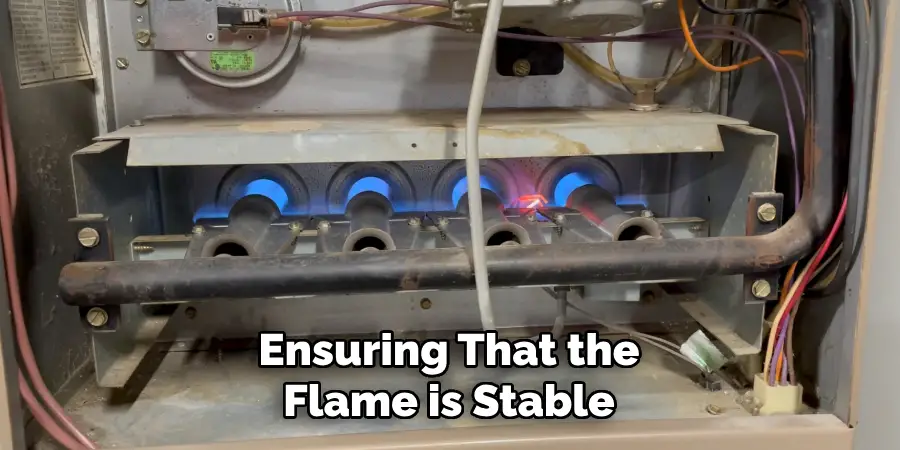
Take note of how quickly your living space reaches the desired temperature and whether the furnace maintains it consistently without frequent on-off cycles, which could suggest an issue. Monitoring the performance not only reassures you of the furnace’s proper functioning but also allows you to detect and address any potential problems early on.
Step 9. Schedule Regular Maintenance:
Scheduling regular maintenance checks is crucial to ensuring the long-term health and efficiency of your furnace. Professional HVAC technicians can perform comprehensive evaluations and cleanings, ensuring your system operates at peak performance.
Regular maintenance helps identify potential issues before they escalate into costly repairs and extends the lifespan of your furnace. Aim to schedule these checks annually, ideally before the onset of the colder months, to guarantee your furnace is in optimal condition when you need it most.
Step 10. Understand Your Furnace’s Operation Cycle:
Becoming familiar with the normal operation cycle of your furnace is beneficial for early detection of any issues. Each furnace has its specific operating rhythm and cycle frequency, which can vary based on model, age, and installation settings.
Understanding what is normal for your unit can help you quickly identify when something is amiss, such as shorter or longer running times, which may indicate a need for maintenance or repair. Keep a record of any changes in operation, as this can be valuable information for technicians during service appointments.
By following these steps and taking preventative measures, you can successfully reignite your furnace with confidence.
5 Additional Tips and Tricks
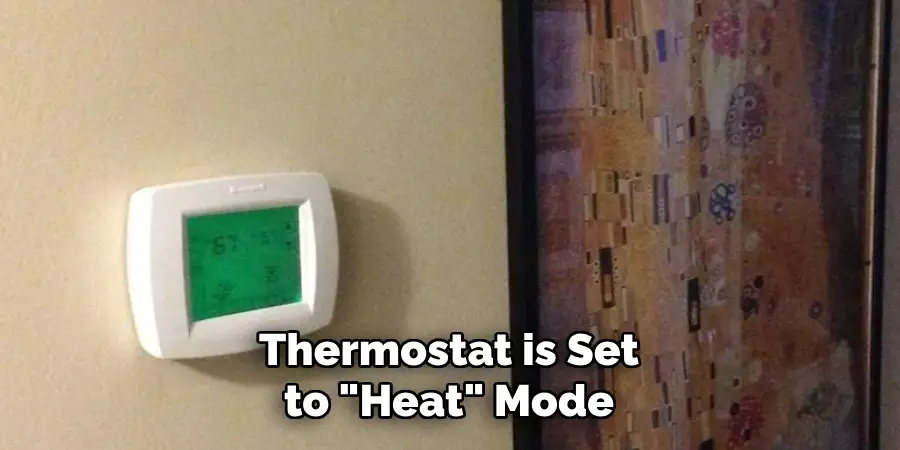
- Check the Thermostat: Before attempting to reignite the furnace, ensure that the thermostat is set to “heat” mode and that the temperature is set higher than the current room temperature. Sometimes, the issue is as simple as incorrect thermostat settings.
- Inspect the Circuit Breaker: If the furnace isn’t turning on, it could be due to a tripped breaker. Locate your electrical panel and check if the furnace’s circuit breaker is in the “Off” position. Flip it back to “On” if necessary.
- Change the Air Filter: A clogged air filter can restrict airflow, causing the furnace to overheat and shut off. Check your air filter and replace it if it is dirty. This simple step can often resolve issues with furnace performance.
- Ensure the Gas Valve is On: If you have a gas furnace, ensure the gas valve leading to the furnace is open. A closed gas valve will prevent the furnace from igniting.
- Reset the Furnace: Locate the furnace switch (it looks like a light switch near your furnace) and turn it off for a minute. Turn it back on to reset the system. This can clear minor electronic issues and allow the furnace to ignite properly.
With these additional tips and tricks, you can quickly and easily reignite your furnace without having to call a professional.
6 Things You Should Avoid
- Ignoring Safety Procedures: Only attempt to work on your furnace by following proper safety guidelines. Always shut off the power and gas supply before starting any work to prevent accidents.
- Tampering with Gas Lines: If you suspect a gas leak or have issues with the gas supply, do not attempt to fix it yourself. Tampering with gas lines can be extremely dangerous. Contact a professional immediately.
- Skipping Regular Maintenance: Trying to reignite a furnace that has been poorly maintained can be futile and dangerous. Regular maintenance is key to ensuring that your furnace operates safely and efficiently.
- Using an Open Flame: Never use matches, lighters, or any open flame to check for gas leaks or to try to reignite the pilot light. This can lead to catastrophic accidents. Opt for safer methods as recommended by your furnace manufacturer.
- Overriding Automatic Safety Features: Modern furnaces come equipped with safety switches and features designed to prevent accidents. Avoid trying to override these features to force the furnace to ignite. This can compromise your safety and the safety of your home.
- Ignoring Warning Signs: If your furnace is consistently experiencing issues, it’s important to address the underlying problem instead of constantly trying to reignite it. Ignoring warning signs can lead to more serious and costly repairs in the future. So, if you notice any strange noises or unusual smells coming from your furnace, make sure to call a professional for help.
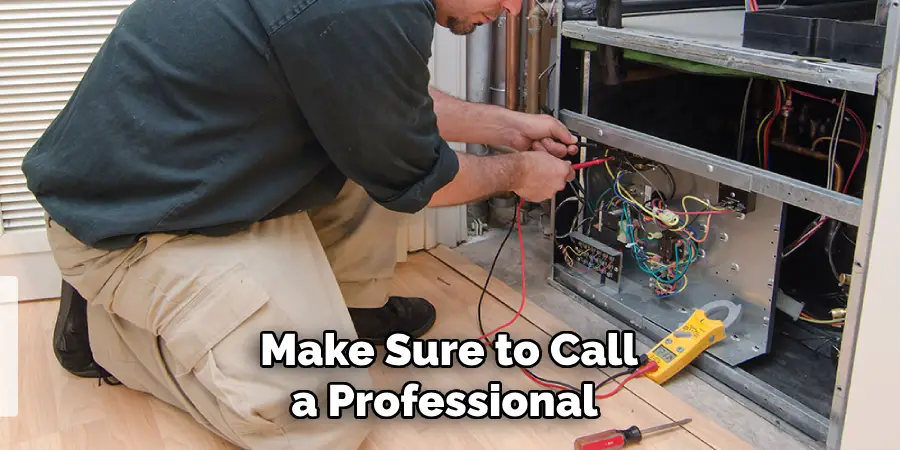
By avoiding these common mistakes, you can ensure that your furnace is safely and successfully reignited.
How Do You Force a Furnace to Restart?
If you’ve exhausted all troubleshooting methods and still can’t get your furnace to reignite, you may need to force it to restart. Here’s how:
- Turn Off the Power: Locate the breaker or switch that controls your furnace and turn it off.
- Wait for 30 Seconds: Give the furnace a short break before attempting to restart it.
- Find the Reset Button: Check your furnace’s manual to locate the reset button. It is typically a small red or black button near the burner assembly.
- Press and Hold the Reset Button: Hold it down for 30 seconds, then release.
- Turn the Power Back on: Flip the breaker/switch back to the “On” position to restore power to the furnace.
- Try Reigniting: Adjust the thermostat to a higher temperature and wait for the furnace to ignite. Repeat the process or call a professional for help if it doesn’t.
Remember, forcing your furnace to restart should only be done as a last resort. If you’re uncomfortable with performing these steps or if they do not work, it’s best to call a professional HVAC technician for assistance.
What are the Disadvantages of Forcing a Furnace to Restart?
While forcing a furnace to restart may be necessary in some cases, there are some potential disadvantages to keep in mind:
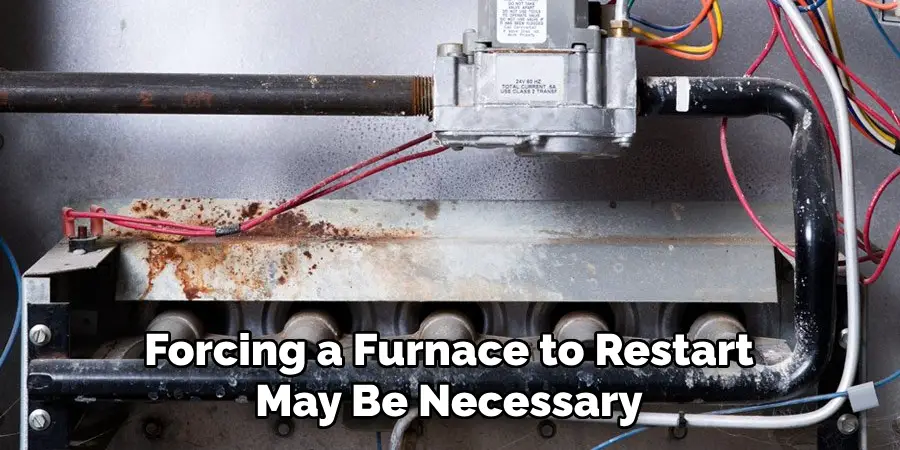
- Safety Concerns: As mentioned earlier, tampering with your furnace can be dangerous. It’s important to follow all safety procedures and guidelines to avoid accidents.
- Potential Damage: If not done correctly, forcing your furnace to restart can damage the system. This could result in costly repairs or even the need for a full replacement.
- Temporary Fix: Forcing your furnace to restart may only provide a temporary solution and not address the underlying issue. It’s important to have a professional inspect and repair your furnace to prevent future problems.
Overall, forcing a furnace to restart should only be done as a last resort and with caution. Regular maintenance and promptly addressing any issues can help prevent the need for forced resets.
What Can Damage Your Furnace?
There are a few common factors that can cause damage to your furnace:
- Lack of Maintenance: Neglecting regular maintenance can cause wear and tear on your furnace, leading to breakdowns and costly repairs.
- Dirty Air Filters: Clogged air filters can restrict airflow, causing strain on the system and potentially damaging internal components.
- Incorrect Installation: Improper installation of a furnace can lead to various issues, including damage to the system and safety hazards.
- Age: As furnaces age, they become more prone to breakdowns and malfunctions. It’s important to have an older furnace regularly inspected and maintained.
By staying on top of maintenance and addressing any potential issues promptly, you can help prevent damage to your furnace and ensure it operates safely and efficiently.
Conclusion
In conclusion, reigniting a furnace involves a series of straightforward steps that homeowners can often perform themselves. From checking the thermostat settings and circuit breakers to changing the air filter and ensuring the gas valve is open, these steps can help troubleshoot and solve many common furnace issues.
However, it’s crucial to prioritize safety by following all guidelines and recognizing when to call in a professional. Regular maintenance must be noticed as it prevents many of these issues from arising in the first place.
By avoiding common mistakes and understanding when a forced restart is necessary, homeowners can ensure their furnace runs safely and efficiently throughout the colder months.
Hopefully, this guide on how to reignite furnace has provided you with the necessary information to confidently reignite your furnace and keep your home warm during the winter season. Stay safe and stay warm!

